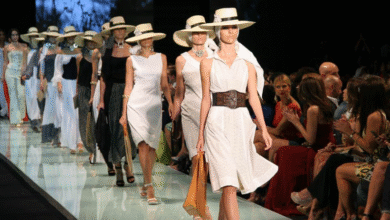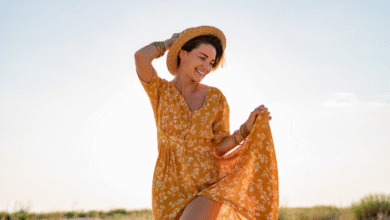The Evolution of Fashion: From Vintage to Modern Styles

Fashion isn’t just about what we wear—it’s a reflection of culture, technology, and personal identity. Over the decades, fashion has gone through an incredible transformation, from vintage elegance to today’s tech-savvy and sustainable styles. In this article, we’ll take a stylish journey through the evolution of fashion, uncovering what shaped each era and how it all leads to modern trends.
Introduction to Fashion Through the Ages
What Defines Fashion?
Fashion is more than clothing—it’s an art form, a social commentary, and a mirror of the times. It represents how people express themselves, adapt to norms, or rebel against them.
Why Fashion Evolves with Time
Fashion changes due to technological advances, shifting societal values, and cultural exchanges. It reflects everything from wars and economic shifts to feminist movements and climate awareness.
The Vintage Fashion Era (1900s–1960s)
Edwardian Elegance (1900s–1910s)
In the early 1900s, fashion was all about opulence. Women wore corsets, long skirts, and elaborate hats, echoing a sense of upper-class refinement.
Flapper Fashion and the Roaring Twenties
The 1920s brought liberation. Hemlines rose, corsets loosened, and the iconic flapper dress with fringe and beads became a symbol of freedom and rebellion.
The Golden Age of Hollywood Glam (1930s–1950s)
From the 1930s to the 1950s, fashion was inspired by Hollywood stars like Marilyn Monroe and Audrey Hepburn. Silhouettes became more feminine, with cinched waists and A-line skirts.
The Mod Movement of the 1960s
Bright colors, mini skirts, and geometric patterns dominated the 1960s. The British invasion influenced the “mod” style, breaking traditional norms with youthful experimentation.
The Transition Period (1970s–1990s)
Disco and Bohemian Vibes of the ’70s
Flowy dresses, bell-bottoms, and platform shoes marked the 1970s. Disco added glitter and glam, while the hippie movement embraced earthy, handmade looks.
Power Dressing and Neon Craze in the ’80s
Big hair, shoulder pads, and flashy colors defined the 1980s. Fashion reflected the rise of women in the workforce with bold suits and structured styles.
Grunge and Minimalism of the ’90s
The 1990s swung the pendulum back to casual. Flannel shirts, ripped jeans, and minimalist aesthetics replaced the flashiness of the ’80s.
Modern Fashion Trends (2000s–2020s)
The Rise of Fast Fashion
Brands like Zara and H&M revolutionized clothing production, offering runway trends at low costs. This democratized fashion but raised concerns over sustainability.
High-Tech Fabrics and Athleisure
Technology brought smart fabrics and performance wear into everyday wardrobes. Athleisure made it stylish to wear leggings and sneakers outside the gym.
Gender Fluidity and Androgynous Styles
Fashion began breaking binary boundaries. Designers started embracing unisex clothing, celebrating diversity in gender identity and expression.
Sustainability and Ethical Clothing
Eco-conscious consumers pushed brands to go green. Upcycling, organic fabrics, and transparent supply chains are now key fashion values.
Influences Shaping Fashion Evolution
Socioeconomic and Cultural Factors
Wars, economic booms, and recessions influenced material use, cuts, and functionality of clothes across decades.
The Role of Celebrities and Influencers
From Audrey Hepburn to Rihanna, celebrities have always influenced fashion. Social media influencers now shape trends faster than ever.
Globalization and Cultural Blending
Globalization brought cross-cultural styles to the forefront—think Japanese streetwear, African prints, and Latin flair blending with Western silhouettes.
Fashion Icons Through the Decades
Audrey Hepburn and Grace Kelly
Style queens of the 1950s, they popularized elegant simplicity—little black dresses, pearls, and gloves.
Madonna and Princess Diana
In the ’80s and ’90s, they redefined fashion rules—Madonna with her edgy attitude, Diana with her sophisticated flair.
Rihanna, Lady Gaga, and Zendaya
These modern icons aren’t afraid to push boundaries, redefine beauty, and experiment boldly with fashion.
Fashion in the Digital Age
Social Media’s Role in Fashion
Instagram and TikTok have become runways of their own, with micro-trends spreading like wildfire.
Virtual Fashion Shows and Digital Runways
Especially after COVID-19, fashion shows moved online. Virtual influencers and 3D fashion design are now mainstream.
Return of Retro: How Vintage Styles Inspire Today
Revival of 90s and Y2K Trends
Crop tops, baggy jeans, and claw clips are back. Nostalgia sells, and Gen Z is leading this retro renaissance.
Thrift Shopping and DIY Fashion Culture
People are embracing second-hand shopping and upcycling. It’s affordable, sustainable, and creative.
The Future of Fashion: Where Are We Headed?
AI in Design and Personalization
Artificial Intelligence helps design personalized outfits based on data—welcome to hyper-custom fashion.
Virtual Clothing and Digital Wardrobes
Digital garments, NFTs, and metaverse avatars are already redefining what it means to get dressed.
How to Mix Vintage and Modern Styles Today
Tips for Styling with Retro Pieces
- Pair vintage jackets with skinny jeans
- Add a modern belt to a vintage dress
- Use old-school patterns with new fabrics
Modern Accessories for Classic Outfits
Sneakers, smartwatches, or minimalist jewelry can update vintage looks for today’s streets.
Regional Fashion Variations Over Time
Western vs. Eastern Evolution
While the West led in trend innovation, the East preserved craftsmanship—think Indian embroidery or Japanese kimono cuts.
African, Asian, and Latin American Influences
These regions have contributed vibrant colors, patterns, and artisanal techniques to the global fashion scene.
Gender and Identity in Fashion History
Breaking Stereotypes
From women wearing trousers to men in skirts, fashion has long challenged gender norms.
Fashion as Expression of Identity
Fashion gives a voice to marginalized groups, allowing them to express their unique identities with pride.
Impact of Movies and Music on Fashion
Hollywood’s Role
Films like Breakfast at Tiffany’s or Clueless set fashion benchmarks for generations.
Rock, Punk, and Hip-Hop Cultures
Music movements created subcultures with strong fashion identities—leather jackets, baggy jeans, and statement jewelry.
Fashion Education and Preservation
Museums and Exhibitions
Institutions like the Met and V&A preserve fashion history, showcasing the art behind the attire.
Fashion Schools and Archives
Top schools like Parsons and Central Saint Martins train future designers while preserving past styles.
FAQs About the Evolution of Fashion
Q1: What’s the main reason fashion keeps changing?
A: Fashion changes to reflect culture, technology, and social movements.
Q2: How has technology affected modern fashion?
A: It introduced smart fabrics, e-commerce, and digital design tools.
Q3: Are vintage clothes still in fashion?
A: Yes! Vintage pieces are often more sustainable and unique.
Q4: How do I mix vintage with modern styles?
A: Pair classic items with trendy accessories and updated silhouettes.
Q5: Who are the top modern fashion icons?
A: Rihanna, Zendaya, and Harry Styles are currently trendsetters.
Q6: What’s the future of sustainable fashion?
A: Expect more eco-friendly fabrics, local production, and circular economy models.
Conclusion: Celebrating Fashion’s Journey
Fashion’s journey from corsets to crop tops, from fast fashion to digital wardrobes, is a story of creativity, rebellion, and reinvention. Understanding The Evolution of Fashion: From Vintage to Modern Styles helps us appreciate our wardrobe choices today and make smarter, more expressive decisions for the future.



